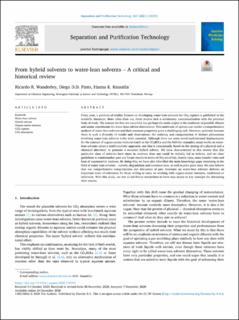| dc.description.abstract | Every year, a plethora of studies focused on developing water-lean solvents for CO2 capture is published in the scientific literature. More often than not, these studies lack a satisfactory contextualization with the previous body of work. The reasons for this are manyfold, but perhaps the main culprit is the multitude of possible diluent and amine constituents for water-lean solvent formulation. This multitude of options can render a comprehensive analysis of water-lean solvents and their common properties quite a challenging task. However, precisely because there is such a diversity of results and observations, the ordering and categorization of distinct phenomena involving water-lean solvents is the more essential. Although there are some novel sophisticated deployements for the concept of organo-amine mixtures (such as the CO2BOLs and the NAS for example), many works on water-lean solvents adopt a traditionalistic approach, one that is conceptually based on the mixing of a physical and a chemical absorbent to generate a so-called hybrid solvent. We have demonstrated in this review that this particular class of solvents have more in common than one could be initially led to believe, and set clear guidelines to contextualize past and future results in terms of CO2 solubility, kinetic rates, mass transfer rates and heat of regeneration analyses. By doing this, we have also identified the main knowledge gaps remaining in the field of water-lean solvents – namely, degradation and corrosion data, as well as pilot plant data. We also believe that our comprehensive categorization and discussion of past literature on water-lean solvents delivers an important trove of references for those willing to carry on working with organo-amine mixtures, traditional or otherwise. With this study, we aim to aid future researchers to have easy access to key concepts for discussing their results. | en_US |

